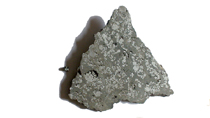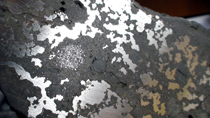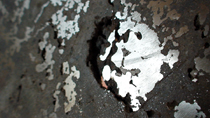Mesosiderites
The mesosiderites are named for the Greek words mesos for
"middle" or "half", and sideros for "iron",
meaning "half iron". In fact, they are typical stony-iron
meteorites, consisting of approximately equal portions of nickel-iron
metal and silicates. Excluding all probable pairings, the mesosiderite
group comprises about 50 distinct members, while seven members represent
witnessed falls.
Texturally, mesosiderites are a complex mixture of a nickel-iron metal
portion and a heavily brecciated silicate portion, consisting of mostly
pyroxene and plagioclase. Strangely, the silicates are obviously evolved
igneous rocks, representing the crust of an achondritic parent body. They
are quite similar to eucrites, diogenites, and other members of the HED
group, even plotting on the same oxygen isotope fractionation line.
However, the metal in mesosiderites is similar to group IIIAB irons,
obviously representing the core of a distinct, differentiated asteroid,
genetically unrelated to the precursor of the eucritic and diogenitic
portion. This suggests a complex formation history for the mesosiderites
and their parent body.
Estherville
Location:Emmet County, Iowa, USA, 43°25'N 94°50'W
Fell:1879, May 10 17:00 hrs.
Type: Mesosiderite-A3/4
Description: Several large masses, of weight of over 700 lb.
(317.5kg), the two largest weighing about 437 lb. (198.1kg) and 151
lb. (68.5 kg) respectively, and hundreds of small fragments of
nickel iron, fell, after detonations and the appearance of a
brilliant fireball. . . . analysis of metal, 9.0% Ni, 9.0 ppm Ga,
52.3 ppm Ge, 2.7 ppm Ir. (From Catalogue of Meteorites (2000)).
|
|
|
|
|
|
|
|
|


|
|
|
|
Estherville
Huge large specimen showing many vacuoles and large
orthopyroxene crystals. A Must !!
1755 gr
SOLD
|


|
|
|
|


|
|
Close Up of the
1755 gr specimen
|
|
|
|


|
|
|
|
|
|
|
|
|
|
|
|
|
|
|
|
|
|
|
|
|
|
|
|
|
|